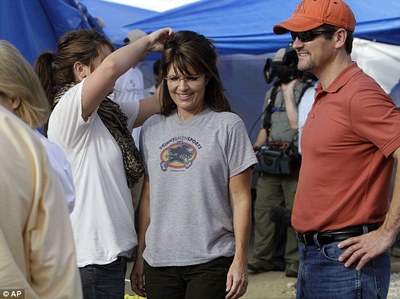
A nice Sforzian moment in Haiti, where Fox News employee Sarah Palin recently got her hair fixed by a stylist, an unwed high school dropout teen mom, during a private tour of preacher Franklin Graham’s cholera compound.
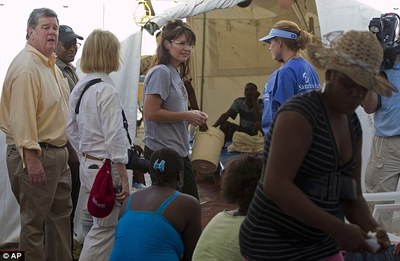
Private except for fellow Fox News commentator Greta van Sustern, and her camera crew. And Greta’s husband John Coale, who is the DC litigator who established Palin’s PAC, and who is described as one of her closest political advisors and the top “Protector of the Palin Brand.”
Ready for her close-up [ap images via dailymail.co.uk]
Thomas Struth On Gerhard Richter
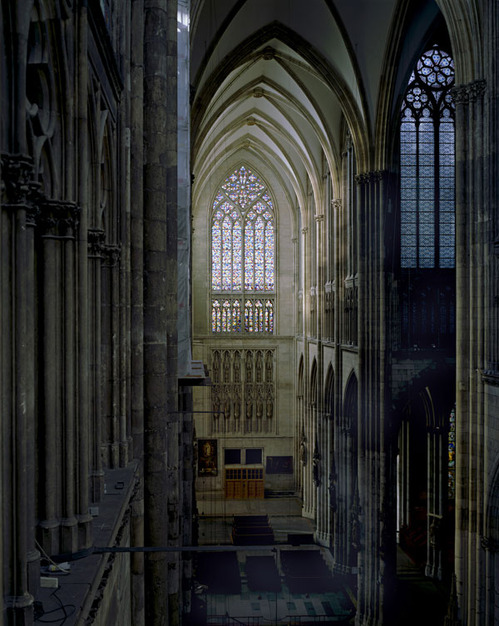
The Minneapolis Institute of Arts has a sweet Struth photo of the Cologne Cathedral, and somehow, Gerhard Richter’s pixel-style stained glass window is not the most awesome thing about it. Also, is that a mop on that ledge in the foreground?
See a larger image, plus the photo in situ, at the top of the MIA’s grand staircase [artsmia.org via eyeteeth]
The Performance Art In Embassies Program
I’m trying to imagine this happening today, or this century–or last, for that matter–and I just can’t. The best account of it I’ve found is from Calvin Tomkins’ 1964 New Yorker profile of Rauschenberg, so I’ll just quote him:
[Rauschenberg and Jean Tinguely] joined forces with several other avant-garde talents to put on a rather bizarre performance in the theatre that is part of the American Embassy.
This spectacle presented simultaneously a motorized Tinguely sculpture that went back and forth across the stage doing a strip tease; a performance, in and around the piano, of John Cage’s “Variation II” by the American pianist David Tudor; a picture-shoot by Niki de Saint-Phalle, Tinguely’s present [sic] wife, who creates her works by firing a .22 rifle at papier-mache constructions in which plastic bags of paint are embedded; and the onstage creation of a painting by Rauschenberg, whose brushstrokes, hammer blows, and other sound effects were amplified by contact microphones attached to the canvas. (Only the back of the painting was visible to the audience, which expected to see the finished work at the end but was denied that pleasure.)
Jasper Johns, who was also having a show in Paris, contributed a painted sign reading “Entr’ Acte” and a large target made of flowers. The performance drew a large and enthusiastic audience, although the Embassy, uncertain what to expect, had forbidden any advance publicity.
I mean, can you imagine it? The performance was June 20, 1961. Johns and Rauschenberg were both in Paris for shows, but from what I can tell, the impetus was the beginning of David Tudor’s European tour. [Though Tudor’s site doesn’t seem to mention a tour.]
“Variation II” is one of Cage’s most complicated, abstract works. Cage’s scores almost always baffle me–when described, they often sound like impossible-to-follow instructions for making a Sol Lewitt wall drawing without a wall–and “Variations II” is no different. Here’s the Getty Research Institute’s explanation:
Cage’s original notation consisted of five points and six lines on eleven individual plastic sheets and instructed the performer to create measurements between the dots, representing sound events, and the lines, representing parameters of sounds (amplitude, duration, overtone structure, frequency (pitch), point of occurrence, number of sounds structuring each event). The resultant measurements defined the parameters of each sound event.
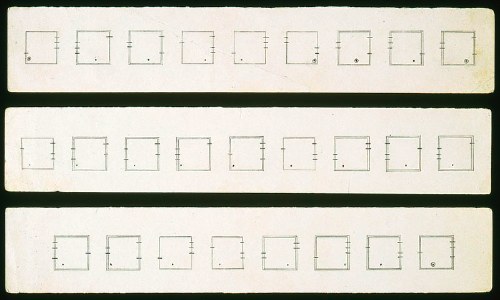
David Tudor, “Nomographs” designed for a realization of John Cage’s Variations II, 1961, image via GRI
Lalalala– what? Got that? Never mind, because Tudor apparently changed it all so much, at least one scholar has called “Variations II” Tudor’s own first composition. [That scholar, James Pritchett, has as clear a description of Tudor’s 1961 performance techniques as I can find, btw. As for audio, the closest approximation I can find is a 1967 “Variations II” performance by Tudor, which obviously doesn’t include his Parisian backup band.]
So far, I haven’t found any documentation of the performance itself. But whatever exists was surely shown at the 2009 Tinguely/Rauschenberg exhibition in Basel I wrote about a little while ago.
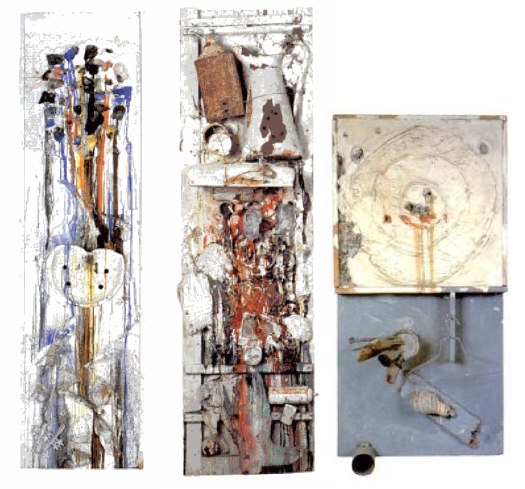
The three Niki de St. Phalle paintings above [not to scale] were all made on the day of the performance, and Shooting Painting American Embassy [left] was in the show, but no actual shooting took place in the embassy. Both Homage to Robert Rauschenberg (Shot by Rauschenberg) [middle] and Tir de Jasper Johns [right] were shot during the day, and her catalogue raisonne says St. Phalle didn’t shoot American Embassy until later.
I’m sure the folks in the Embassy were relieved.
Previously: the State Department and modernism in the 1960s
the de la Cruzes loan a Felix candy pour to the Art in Embassies Program
an amazing memo from Nixon calling for a purge of the “little uglies,” aka contemporary artworks, from embassies
Television’s Force Field Of Inaction
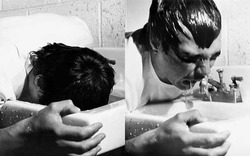 I realize I only tweeted it, and that doesn’t count, so I’ll say it here: Nick Stillman’s essay about Chris Burden’s television-based work at East of Borneo is great stuff:
I realize I only tweeted it, and that doesn’t count, so I’ll say it here: Nick Stillman’s essay about Chris Burden’s television-based work at East of Borneo is great stuff:
Velvet Water feels like the culmination of a thread that began with Shoot. That performance actualized the sensationalistic stuff of TV dramas and the nightly news. But aside from its sociopolitical connotations, it contained heroic connotations of Burden as lone survivor. He was very much the performance’s sole subject. Velvet Water retains the vivid political suggestiveness that spikes many of Burden’s best performances. His auto-torture is evocatively similar to how the French police torture the Algerian sympathizer Bruno Forestier in Godard’s Le Petit Soldat (1963), not to mention any number of modern waterboarding videos, but I would argue that the audience–not Burden–was the unwitting subject of the performance. Burden had by this point established a reputation for being a careful, responsible coordinator of his own performances. He must have known that nobody would interrupt him. But he was also clearly choking, and was probably close enough to the spectators that his gasps were audible not only from the television monitor but also in real time, from the adjacent room. Unlike in Do You Believe in Television, where his physical presence was only implied, those present at Velvet Water knew he was right there with them. They were set up as examples of conditioned passivity in the presence of a television set. As Robert Horvitz wrote of the work, in Artforum in 1976, “The electronic link between him and the audience tacitly implicated them in this ordeal, even as it seemed to distance them sensually.” Burden–onscreen and thus invincible–was demonstrating television’s force field of inaction.
Do You Believe in Television? Chris Burden and TV [eastofborneo.org]
Previous Burden coverage on greg.org: the TV ad, and how we can all put ads on TV now, too; the B-Car; remaking Beam Drop.
Italian Line, Farm Journal
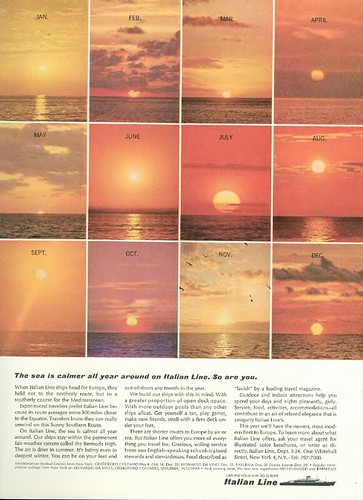
The New Yorker obsoleted my old New Yorker Magazine Database by finally letting Google index their website and adding a search function, and making their archive available online, and that’s as it should be.
But whenever I browse the DVD facsimile of the magazine’s archive, I am reminded of how much content remains unindexed and invisible. So maybe it’s time to liberate the vintage ads of the world from their back issue prisons. Because if I can find ads this awesome completely at random, don’t you wonder what else is out there?
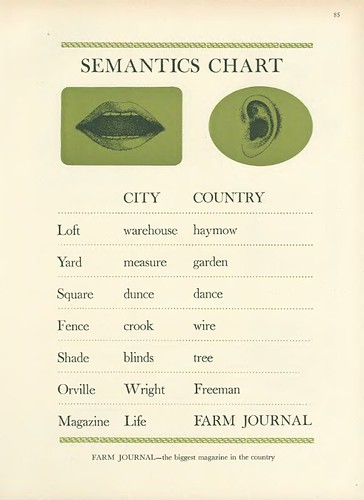
Haymow!
Van Gogh, Haring, Razzle Dazzle: Car Camo Wraps

I love it when a tossed-off plan comes together. In this case, it’s the idea of artist-designed vinyl car wraps. And camo.
The Times had a great story about auto spyshots, and the increasing use of camouflage vinyl wraps on test cars. Some of the wraps seem designed to thwart a spy photographer’s focus, or at least to obscure the contours and details of the car.
The different patterns are discussed as resembling “a Keith Haring painting,” and “World War I ‘dazzle ships,'” or as sporting the swirly, painterly “Van Gogh Look.”
It should only be a matter of time before a collection of contemporary artist vinyl wraps hits the streets. Right?
Secret Cars Kept Under Wraps, in Public [nyt via slow and steady wins the race]
Previously:
The Jeff Koons wrapped BMW
Vinyl wrapped art car: Hirst]
First or worst? Peter Max decal car c. 1968
Razzle Dazzle and Dutch Google Maps camo
OG WWI dazzle design and the Koons revival
Short Circuit Flag: Finch Is Off The Hook
There’s some interesting background info as well, but the big news [sic] today in piecing together the history of Rauschenberg’s Short Circuit is that Finch College is off the hook–and Holland Cotter is right after all.
Continue reading “Short Circuit Flag: Finch Is Off The Hook”
James Turrell At Kijkduin
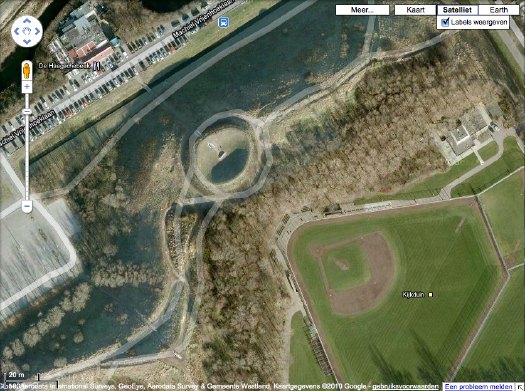
Does an Anglo calling The Hague “Den Haag” sound as obnoxious as one calling Florence “Firenze” or Milan “Milano”? This is not a rhetorical question. I really need to know.

Celestial Vault in 1996, James Turrell, image via: stroom.nl
In 1996, Stroom, the contemporary arts center in Den Haag [!] commissioned a permanent public sculpture from James Turrell. And while Stroom has certainly achieved much since then, it still seems like the most prominent/significant thing they’ve ever done.
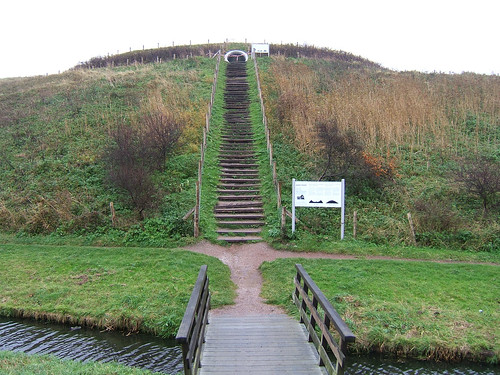
Celestial Vault was built in Kijkduin, a duney seaside suburb about a 20-min. bus ride from the center of town. It consists of two parts: a contoured, elliptical, crater-shaped earthwork with an inclined viewing platform at the center, and an another platform installed on a higher, adjacent hilltop.
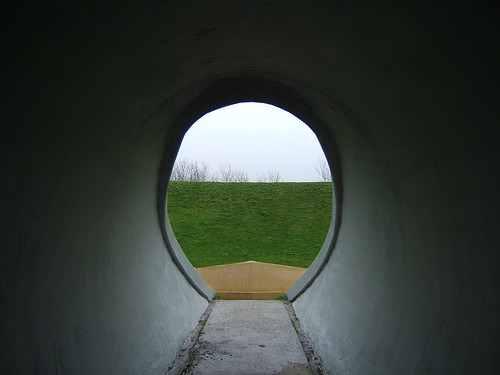
The weather and use had taken a toll, and so in 2008, a significant effort to restore Celestial Vault was undertaken. Stroom’s website says the work is open to visit, so I did, only to find warning tape placed across the tunnel entrance to the crater. Obviously, I went in anyway. [On Google Maps, the dune crater looks to be hard up against a restaurant and a baseball diamond, of all things. When you visit it, the topography is such that these both fall completely away.]
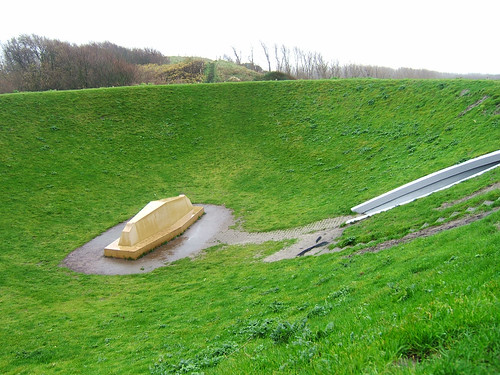
It seems so online, and it was really apparent in person, that Celestial Vault functions as a kind of experiment or test run for Turrell’s project to reshape Roden Crater. For that reason alone, it seems like it should get more attention than it does. [Is it just me? I follow Turrell’s work, and his 1993 retrospective at ICA Philadelphia is a longtime favorite, but it seems the Roden Crater hype overshadows everything else. I’d never heard of Kijkduin, and frankly stumbled on it by accident on my morning visit to Den Haag.]
Also, it’s actually built. And you can see it without being on a 10,000-year waitlist or whatever Roden Crater’s gonna have.
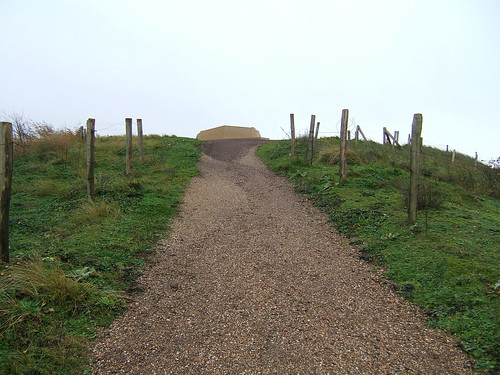
All that said, I confess I couldn’t get Turrell’s vaunted vaulting effect to work. Maybe I didn’t stay still long enough of free my mind or unfocus my eyes or whatever long enough. Maybe I was focusing too much on the rain that was falling on me the entire day. But Turrell [and the Dutch, for that matter] are rather specific about the material qualities of Kijkduin light, and the overcast, rainy lightbox effect IS pretty standard there on the North Sea.
So maybe it was me, and I was wrong to expect something less subtle, a more special-effectsy, fish-eye lens distortion.
Because what you end up with–or what I ended up with, anyway–was a view of the sky where the [shaped] horizon line hovers just barely on the edge of your peripheral vision. The fact that the vaulting worked almost the same way with the actual horizon line, which Turrell used on the hilltop platform, kind of makes you wonder if the whole earthworking effort isn’t more for its own sculptural properties than for facilitating any actual retinal impact.
It’s a question Turrell seems to have been asking himself, by placing these two identical viewing platforms side by side, but in opposite geographic situations. I guess since work really picked up at Roden Crater since Kijkduin was built, Turrell got the answer he was looking for.
Stroom page with info and tons of photos: James Turrell – Celestial Vault, Kijkduin, Den Haag [stroom.nl]
Celestial Vault on Google Maps [google]
My Turrell @ Kijkduin photoset on flickr [flickr]
Whoa, James Seawright
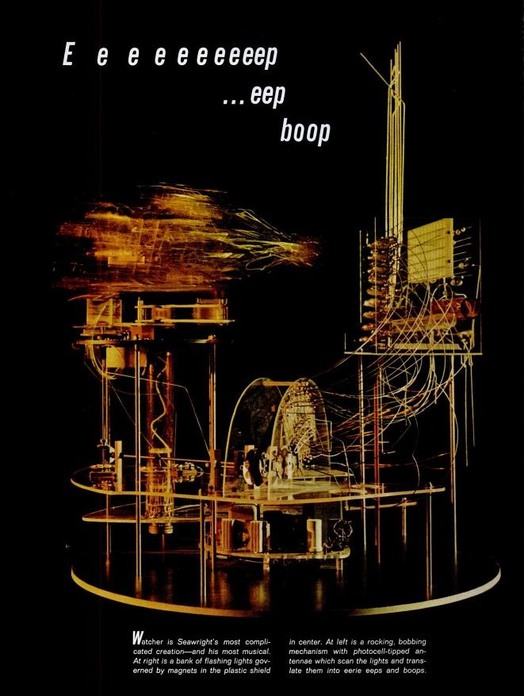
It’s crazy sometimes how long it takes to see what’s right in front of your face. I’ve been thisclose to artist James Seawright’s kinetic and electronic sculptures over the last couple of years, and yet I only really discovered them yesterday.
Seawright, who was for a long time the head of visual arts at Princeton, began making Bauhaus-inspired light and sound performance works with his dancer wife in the early 1960s. Bauhaus in this case meant Laszlo Moholy-Nagy, whose Light Space Modulator has been much discussed around here.
Trained as an engineer, Seawright began taking sculpture classes at the Art Students League in New York, and scored a solo show at Stable Gallery in 1966. Among his awesome work in that show: Watcher (1965) [above, from a 1967 LIFE Magazine spread.]
Like much of Seawright’s work, Watcher is designed to activate and react to the presence of the viewer–or to itself–via photovoltaic sensors. It looks remarkably similar, both formally and functionally, to the Eames Solar Do-Nothing Machine (1958).
After his Stable Gallery show, Seawright was involved in shows at Howard Wise, and was one of a handful of artists–along with Allan Kaprow, Otto Piene and Heinz Mack–to participate in The Medium is The Medium, an early experiment in video art/”tele-Happenings” produced by WGBH in 1969. Which I now must watch again, for the Seawright part.
James Seawright [wikipedia]
seawright.net [the artist’s portfolio site]
Gala As Art Talk: The Making Of
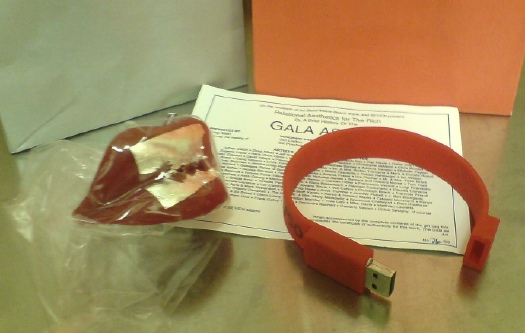
I was nervous, I admit, but I really had a blast last week giving my Gala As Art presentation last week at #rank. The crowd was great; the other #rank folks I met were nice, with interesting projects and conversations; SEVEN looked fantastic, a really smart, low-key way to show a fair’s worth of work [I hope all the participating galleries made a bundle of money.]
It seemed obvious that the talk required gift bags, so I decided to do them as an edition. The artist-licensed perfume I hoped to include didn’t pan out, though. I’d toyed with the idea, no pun intended, of making a version of Marina Abramovic’s party favor/dessert for the The Artist is Present gala, where the dessert art foundry Kreemart cast her lips in Belgian chocolate covered with gold leaf.
Then I priced edible gold leaf, and opted for silver leaf on edible wax lips, which really set the gift bag’s entire color scheme. [Actually, Diet Coke probably set the color scheme without me being aware of it.] Applying silver leaf was a pain in the butt, but there were only a couple of rejects. They traveled amazingly well, thanks to Jean’s careful wrapping. The certificate is designed like an invite, with a bajillion artists and collectors and curators on the committee, everyone I mentioned [or planned to, anyway.]
And at the last minute, I decided that burning and printing 50 DVDs full of the gala-related video and pdf files I’d assembled would be not so interesting. [A friend pointed out that no one ever opens the jewelcases in their gift bags, and I realized, in 20 years, I never had either.]
So I hustled to find a cool USB drive I could load. Maybe get my logo or url on it. Or maybe find anything at all in stock. Finally, I found exactly what I was looking for, and I ended up loading, signing and numbering the silicone bracelet flash drives the morning I left.
I’m discussing them at length here because they’re apparently so stealth, several people didn’t realize they were anything more than a wristband. So now you know. I saved a couple for the archive. And because I didn’t want to leave the lips melting in the trunk, I ended up not going to Art Basel at all. Crazy.
Meanwhile, I’m trying to find the best/easiest way to release the slideshow and audio together, either as a screencast or a podcast or something. Watch this space.
Jasper Johns’ ‘Short Circuit’ Flag: One Place It Isn’t
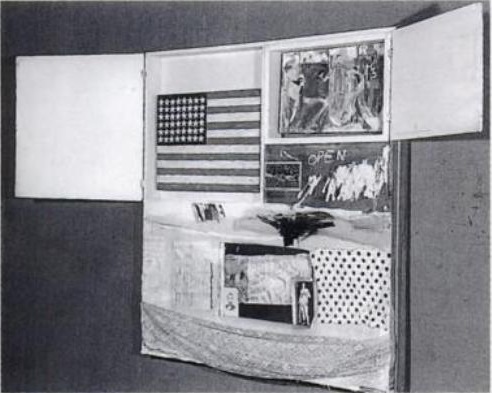
After a brief break, during which I briefly pwned Miami Art Basel, the search for the Jasper Johns flag painting which was included in Robert Rauschenberg’s 1955 combine-painting Short Circuit [above], continues.
Actually, because I had to carry on the oddball contents of the gift bags I did for my #rank presentation, I went to the airport freakishly early and ended up with extra lounge time, which let me read through all the details and footnotes in my pristine, OG copy [apparently from the library of Artforum!] of Dr. Roberta Bernstein’s definitive 1985 dissertation-cum-catalogue raisonné, Jasper Johns’ Paintings and Sculptures 1954-1974, “The Changing Focus of the Eye.”
Only guess what, it wasn’t there. Not a mention, not a photo, not a footnote, not a trace.
[UPDATE: Since posting this in December, I have communicated with Dr. Bernstein about the Short Circuit flag and its absence from her thesis, as well as its status in her forthcoming Johns catalogue raisonne. Scroll down for her gracious and informative reply.]
Continue reading “Jasper Johns’ ‘Short Circuit’ Flag: One Place It Isn’t”
Dance + The Whole World = The Whole World
Via Ubu comes a provocative essay, “Constructed Anarchy,” from the poet and John Cage critic Marjorie Perloff. She takes the death of Merce Cunningham and the company’s plans to dissolve after a worldwide farewell tour as an opportunity to ask a tough question of Cunningham’s and Cage’s philosophy: basically, if art is life, what happens to it after you’re dead?
When in June 2010 I had the chance to see Roaratorio performed at the Disney Concert Hall–a beautiful Roaratorio but no longer graced by the presence on stage of Merce or by the actual speaking voice of John Cage–what seemed especially remarkable was the tight formal structure of a composition once billed (both in its radio and dance incarnations) as an anarchic Irish Circus, bursting with random sounds and unforeseen events. For, however differential the leg, arm, and torso movements of the individual dancers (sometimes in pairs or threes, sometimes alone), all are metonymically related in a network of family resemblances, and all are, as the charts show, mathematically organized. Yet wasn’t it Cage who defined his music as “purposeless play”–“not an attempt to bring order out of chaos . . . but simply a way of waking up to the very life we’re living, which is so excellent once one gets one’s mind and one’s desires out of its way and lets it act of its own accord”? And wasn’t it Cunningham who insisted that dance “is not meant to represent something else, whether psychological, literary, or aesthetic. It relates much more to everyday experience, daily life, watching people as they move in the streets”?
The very life we’re living: the Gelassenheit so seemingly central to Cage-Cunningham was hardly anarchic, much less unpredictable. But their own statements, and hence the critical writings about their work, have regularly insisted on what Joan Retallack, in her seminal series of conversations with Cage, calls “an aesthetic pragmatics of everyday life.” “[Cage] told me,” she recalls in her Introduction, that “the art that he valued was not separated from the rest of life. . . . The so-called gap between art and life didn’t have to exist” (Musicage xix-xx). And Cunningham repeatedly made the same point, using traditional ballet as contrast.
Or that’s how it used to be.
It sounds convincing: to see RainForest or Roadrunners, Channels/ Inserts or Beach Birds, is to perceive that there is no central focus or storyline, no prima ballerina flanked by a corps de ballet, no symmetry or detectable unifying principle. But if the dancers are free to introduce their own variations and tempo, if the piece is as non-hierarchical and collaborative as Merce suggests, why has each work (dance and music) been plotted out geometrically and arithmetically? Why have the dancers received so much less acclaim than Cunningham himself, in his role as director /producer /choreographer? And why has the decision been made that the ensemble will not be able to function without him? Similar questions can be put about Cage’s work: is his recorded voice reading Roaratorio essential to the work? Can a “decentered” Cage Musicircus perform without Cage?
The more we probe such Cunningham-Cage concepts as “free form” or “anarchy,” the more apparent it becomes that theirs is an anarchy that is carefully simulated. Their works are by no means “happenings,” in Allan Kaprow’s sense of the word, nor is Cunningham producing performance art.
As in Duchamp’s case, no “accident” is really accidental, and discipline is central. [emphasis added because, yow, kinda harsh]
Perloff’s argument is definitely worth a read, and she had a front row seat–and she quotes longtime Merce collaborator Carolyn Brown and others–on Merce and Cage’s egos and steely artistic wills, which seem to undermine a carefully cultivated [or at least prevailing] laissez-faire, see-what-happens image.
But I’m just half-informed enough to take issue with Perloff’s takedown. She sets up seeming contradictions between professions of randomness and artistic control, but I think that’s false and unfair. Cage wasn’t an evangelist for randomness, nor for anarchy, but for chance and chance operations. And there’s a meaningful difference that I suspect Perloff knows well.
Randomness is whatever happens, but chance operations is a tool for determining what happens. Perhaps Cage and Cunningham’s meant their obliteration of the distinction between art and life, between music and sound, between dance and movement, to be a production strategy for the artist, not a life strategy the audience.
Constructed Anarchy [lanaturnerjournal.com via ubu]
Interesting/related, and the 2nd time in 2 days to see Cage compared to Warhol: Ubu founder Kenneth Goldsmith’s 1992 review of Perloff’s first posthumous Cage essay. [electronic poetry center]
Bruce Weber’s Next Book Will Be Titled, Let Me Help You Out Of Those Wet Things
In my talk at #rank in Miami Friday, I called for more scholarship on the growing genre of yacht art. Which, via this NY Times Style section slideshow caption, now includes at least one work of hybridized performance/institutional book party critique by the artist Al Czervik:
During a high school band performance at the Bruce Weber and Andre Balazs party at the Standard Hotel, a massive yacht passed the dock, sending three enormous waves crashing up through the dock, drenching the guests.
Until Taiwanese animated news comes up with something, this youtube video will have to do.
Johns, Merce, Duchamp: Walkaround Time
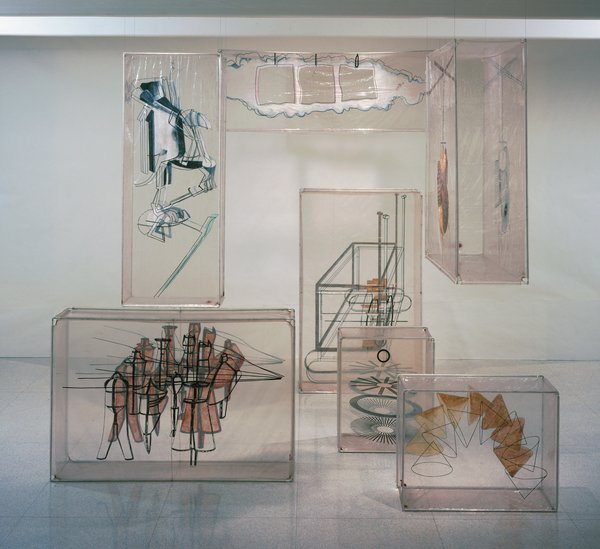
image: walkerart.org
Welcome to one of the oldest tabs in my browser: the inflatable balloon set for Merce Cunningham’s 1968 piece, Walkaround Time, which is based on Marcel Duchamp’s Large Glass, which was made by the company’s artistic director at the time, Jasper Johns.
I’d backed into the pieces–seven cubes of silkscreen-and-paint on clear vinyl, reinforced with aluminum frames–a few months ago, and realized I’d seen them–and not thought much about them–at the opening of the newly expanded Walker Art Center in 2005.
Which I now regret, but which makes Merce’s title resonate a little more. Cunningham dancer and longtime collaborator Carolyn Brown explains that Walkaround Time was a reference to a particular kind of purposeless movement taken from ancient computer history, when “programmers walked about while waiting for their giant room-sized computers to complete their work.” It’s just taken me this long to appreciate–or even to see–the work. And for some great additional links to appear.
I can already tell this is going to go long.
03/2012 UPDATE: Unfortunately, none other than former MCDC stage manager Lew Lloyd informs me that the term “balloon” is not really accurate; they were transparent vinyl boxes fit onto armatures, which could be broken down for travel. Given my noted satelloon bias, I will still think of them as balloons in my heart. For the rest of you, though, remember: not balloons. [end update]
‘It Gets Better’ Doesn’t Mean The Bullying Stops

I recently went with my daughters to see “Hide/Seek” at The National Portrait Gallery. They’re 2 and 6, so most of the content of the show is way over their heads. [Much of the work, like the vintage photographs, was literally over their heads.]
Felix Gonzalez-Torres’ shiny, multi-colored candy pour, Untitled (Portrait of Ross in LA) was an immediate and repeated hit. As my kids were going back for “just one more piece,” I laughed with other visitors at the sign the museum had posted next to it, warning that these small candies might pose a choke hazard.
At first I was going to write that we mostly stuck to the bright, colorful works, but that’s not correct. While a giant camo Warhol was front and center, and the kids both recognized it immediately, I didn’t think either one would be ready for the most colorful work in the show, A.A. Bronson’s massive, epic portrait of his AIDS-ravaged partner Felix’s body. Fortunately, the curators had placed it in its own semi-enclosed niche, to the side. It was a careful presentation of a devastating and important work, thoughtfully non-confrontational without seeming sequestered or hidden.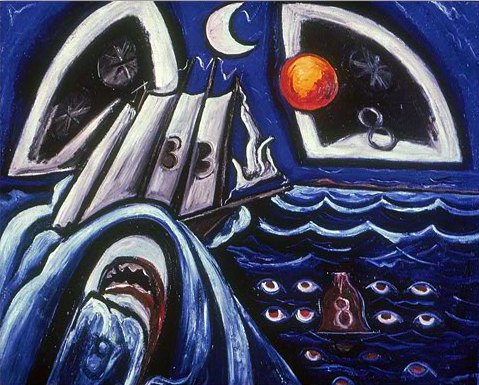
We saw Jasper Johns’ face on a plate. Larry Rivers’ giant nude portrait of Frank O’Hara, which was hard to miss, of course. We played I Spy with some of Marsden Hartley’s elements–the ship, the waves, the bells, the sun &moon, the shark–in his Memorial for Hart Crane. The older kid read the title, so we talked about the painting for his friend who drowned. I couldn’t not tell her that Crane had jumped from the ship, not fallen. No, I didn’t know why, except that he must have been very, very sad and thought that his life was so bad, it’d be better to be dead. Which we decided did not make sense and was not true.
We saw the lady in the tuxedo and laughed at the very idea that long ago, some people thought only men could do things like work, or vote, or paint. And that there were things people thought only women do that men shouldn’t–like pose nude for a painting [gesture to giant, nude Frank O’Hara].
We talked about David Wojnarowicz’s self-portrait, above. And that when he knew he was dying, he made a picture that looked like he was buried. Or maybe it looked like he was coming out of the ground.
There were two small video monitors and a touchscreen, which attracted the 2yo like a giant iPad, but we didn’t come to a museum to watch TV [this time.] One turns out to have been an excerpt from the David Wojnarowicz film, A Fire In My Belly, which the NPG just censored on the demand of William Donohue of the Catholic League, the self-appointed arbiter of offenses to Christian sensibilities. Republican leaders in the House of Representatives seized on the work and the show and demanded the Smithsonian cancel it immediately.
Pulling Wojnarowicz’s work in the face of such bullying is a breathtakingly cowardly betrayal by the museum, one which either ignores or mocks the artist’s own work and history. That it’s happening on World AIDS Day, that Wojnarowicz’ work is singled out for silencing on what used to be called A Day Without Art, is deeply offensive and damaging to the artist, the show, the curators, the museum, and to the principles of our country.
From Michael Kimmelman’s obituary for Wojnarowicz in 1992:
Like the artist himself, his art never pulled punches. Mr. Wojnarowicz gained the national spotlight in 1989, when the National Endowment for the Arts decided to rescind money for a catalogue to an exhibition about AIDS because of an essay in which he attacked various public figures. The endowment reversed itself. It also supported a 10-year retrospective of his work that was organized at the University Galleries of Illinois State University in Normal, Ill., which included a catalogue that reproduced the essay.
Mr. Wojnarowicz was in the news again after the American Family Association of Tupelo, Miss., an antipornography lobbying group, and its leader, the Rev. Donald E. Wildmon, issued a pamphlet criticizing the endowment. The pamphlet included photographs cropped from works by Mr. Wojnarowicz that included sexual images. The artist sued the organization for misrepresenting him and damaging his reputation. In 1990, a Federal District Court judge in New York ruled in his favor and ordered that the organization publish and distribute a correction. Mr. Wojnarowicz was the only artist to challenge Mr. Wildmon in court.
If the exact same people and groups attack the exact same artists and institutions and outcome is actually more punitive–remember, the NEA reversed itself and Wojnarowicz stood up to his critics and won–how can we call it progress? It doesn’t get better by itself.
update: Incredible. Tyler’s confirmed [2024: link updated] that it was Smithsonian Secretary Wayne Clough who ordered the Wojnarowicz video pulled. From the way it went down, it sounds like he censored the video over the objections of the NPG staff–and without even watching it himself. Not that the content is at all obscene or even offensive. To anyone whose job isn’t professional offensetaker, that is.
